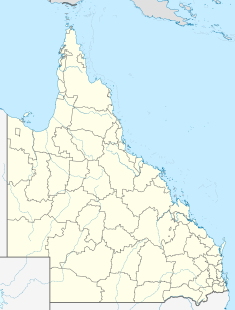
Manor Apartment Hotel is a heritage-listed former office building and now apartment hotel at 289 Queen Street, Brisbane City, City of Brisbane, Queensland, Australia. It was designed by Hennessey, Hennessey & Co and built from 1930 to 1931 by Concrete Constructions (QLD) Limited. It is also known as Colonial Mutual Life Building and Newspaper House. It was added to the Queensland Heritage Register on 21 October 1992.

Colonial Mutual Chambers is a heritage-listed office building at 62 Queen Street, Brisbane City, City of Brisbane, Queensland, Australia. It was designed by Richard Gailey and built in 1883 by W McPark. It is also known as Sussans Building. It was added to the Queensland Heritage Register on 21 August 1992.

Hardy Brothers Building is a heritage-listed shop at 116 Queen Street, Brisbane City, City of Brisbane, Queensland, Australia. It was designed by Richard Gailey and built in 1881. It is also known as Love's Auction Mart. It was added to the Queensland Heritage Register on 21 October 1992.

Karingal Chambers is a heritage-listed shopping centre at 386-388 Ruthven Street, Toowoomba, Toowoomba Region, Queensland, Australia. It was designed by Henry James (Harry) Marks and built from c. 1913 to c. 1913. It is also known as Krimmers Chambers and Rowbotham Chambers. It was added to the Queensland Heritage Register on 28 April 1997.
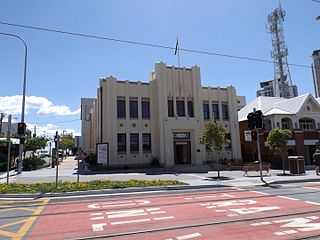
Southport Town Hall is a heritage-listed former town hall at Nerang Street, Southport, Gold Coast City, Queensland, Australia. It was designed by Hall & Phillips and built in 1935 by H Cheetham. It is also known as Gold Coast City Hall, Gold Coast Town Hall, and South Coast Town Hall. It was added to the Queensland Heritage Register on 5 October 1998.
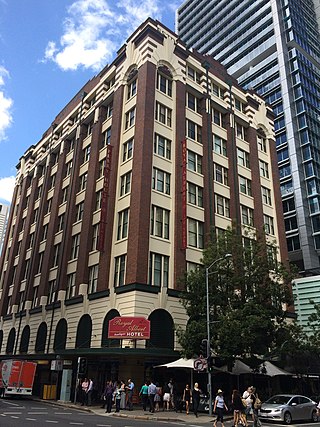
Perry House is a heritage-listed office building at 167 Albert Street, Brisbane City, Queensland, Australia. It was designed by Claude William Chambers and built from 1911 to 1923 by Thomas Keenan. It is also known as Royal Albert Apartments. It was added to the Queensland Heritage Register on 27 October 1994.

MacArthur Chambers is a heritage-listed former office building at 229 Queen Street, Brisbane City, City of Brisbane, Queensland, Australia. It was designed by Francis Richard Hall and built from 1931 to 1934 by George Alexander Stronach. It was also known as the AMP Building. It was added to the Queensland Heritage Register on 21 October 1992.

Hillyards Shop House is a heritage-listed general store at 615 Stanley Street, Woolloongabba, City of Brisbane, Queensland, Australia. It was built c. 1865 and remodelled in the 1920s. It was added to the Queensland Heritage Register on 21 October 1992.

United Service Club Premises is a heritage-listed club house at 183 Wickham Terrace, Spring Hill, City of Brisbane, Queensland, Australia. It was designed by architect Claude William Chambers and built from 1906 to 1947. It is also known as Montpelier and The Green House. It was added to the Queensland Heritage Register on 28 April 2000.

Inchcolm is a heritage-listed former office building at 73 Wickham Terrace, Spring Hill, City of Brisbane, Queensland, Australia. It was designed by Eric P Trewern and built in 1930 by J I Green & Son. It was converted into a hotel in 1998, and renovated in 2014. It now trades as Ovolo Inchcolm under the Ovolo Hotels Group. It was added to the Queensland Heritage Register on 23 March 1998.

Wickham House is a heritage-listed office building at 155–157 Wickham Terrace, Spring Hill, City of Brisbane, Queensland, Australia. It was designed by Francis Richard Hall and built from 1923 to 1924 by F J Corbett. It was added to the Queensland Heritage Register on 23 June 2000.
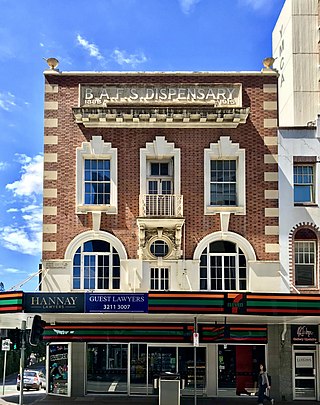
BAFS Building is a heritage-listed former pharmacy at 331 & 333 George Street, Brisbane City, City of Brisbane, Queensland, Australia. It was designed by Lange Leopold Powell and built from 1915 to 1916 by B Cunningham. It was added to the Queensland Heritage Register on 22 February 2002.

Transcontinental Hotel is a heritage-listed hotel at 462-468 George Street, Brisbane City, City of Brisbane, Queensland, Australia. It was designed by Francis Drummond Greville Stanley and built from 1883 to 1884. It was added to the Queensland Heritage Register on 21 October 1992.

Treasury Hotel is a heritage-listed hotel at 175 George Street, Brisbane City, City of Brisbane, Queensland, Australia. It was designed by John Hall & Son and built from 1887 to 1888 by Abraham James. It was added to the Queensland Heritage Register on 4 November 1993.

Hunters Buildings is a heritage-listed group of commercial buildings at 179–191 George Street, Brisbane City, City of Brisbane, Queensland, Australia. The individual buildings are Treasury Chambers, St Francis House, and Symons Building. They were designed by Richard Gailey and built in 1886 by George Gazzard. They were added to the Queensland Heritage Register on 21 October 1992.

National Mutual Life Building is a heritage-listed office building at 299 Queen Street, Brisbane City, City of Brisbane, Queensland, Australia. It was designed by Gibbs, Finlay & Morsby in conjunction with Thomas Blair Moncrieff Wightman and was built in 1926 by J L Green & Sons. It is also known as Metway Chambers and Custom Credit House. It was added to the Queensland Heritage Register on 21 October 1992.

Hotel Metropole is a heritage-listed hotel at 253 Brisbane Street, West Ipswich, City of Ipswich, Queensland, Australia. It was designed by George Brockwell Gill and built in 1906. It was added to the Queensland Heritage Register on 21 October 1992.

Bostock Chambers is a heritage-listed office building at 169-175 Brisbane Street, Ipswich, City of Ipswich, Queensland, Australia. It was designed by George Brockwell Gill and built in 1915. It was added to the Queensland Heritage Register on 21 October 1992.
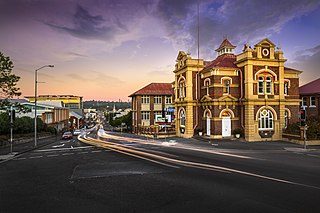
Queen Victoria Silver Jubilee Memorial Technical College is a heritage-listed technical college at 88 Limestone Street, Ipswich, City of Ipswich, Queensland, Australia. It was designed by architect George Brockwell Gill and built from 1897 to 1937. It is also known as Ipswich TAFE College and Ipswich Technical College. It was added to the Queensland Heritage Register on 21 October 1992.

The Heritage Hotel is a heritage-listed hotel at 230 Quay Street, Rockhampton, Rockhampton Region, Queensland, Australia. It was designed by John William Wilson and built in 1898 by John Kerslake Evans. It is also known as the Old Colonial Hotel and the Commercial Hotel. It was added to the Queensland Heritage Register on 21 October 1992.

